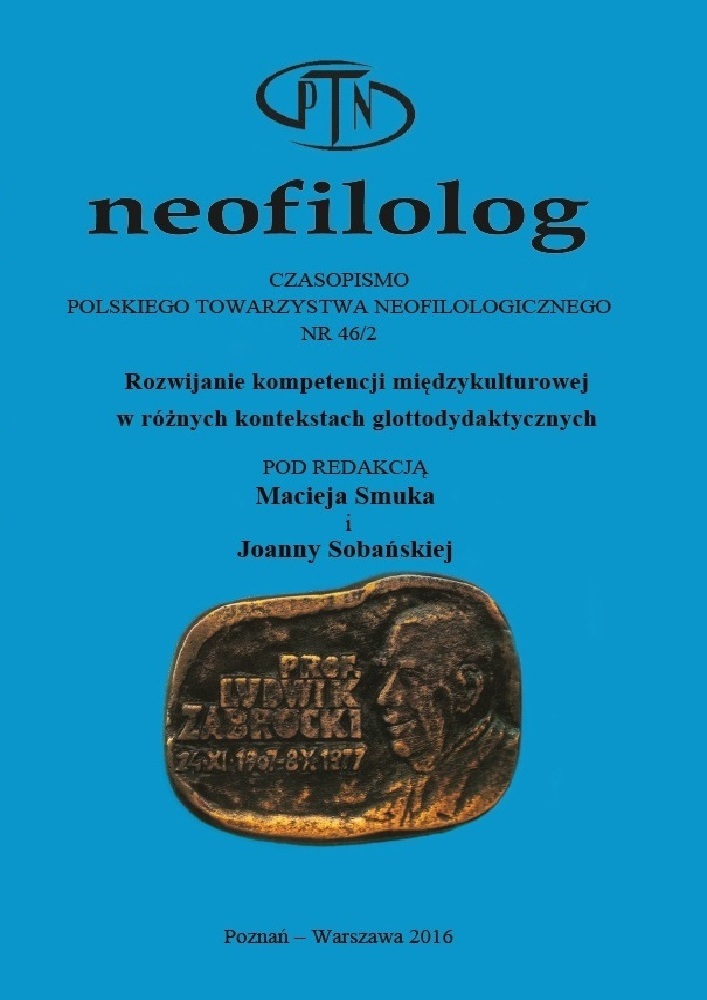Résumé
The supporters of the concept of multilingualism and interculturalism emphasize that learning new languages is more effective when one consciously refers to the past and current experiences in the exploration and use of languages. A person who, in addition to the mother tongue, learned a foreign language and knows how to use it, not only possesses a skill set needed in the process of learning but also has the information about a language system. Referring to the available research on multilingualism, this article outlines the methods of utilizing this potential during foreign language classes and of preparing the ground for a complex program of teaching additional languages.
Références
Brohy, C. 2008. „Didactique intégrée des langues: évolution et définitions”. Babylonia, 1: 9-11.
Candelier, M., Camillieri-Grima A., Castellotti, V., De Pietro, J.-F., Lörincz, I., Meißner, F.-J., Noguerol, A., Schröder-Sura, A. i M. Molinié. 2007. FREPA. Framework of refer-ence for pluralistic approaches to languages and cultures. Strasbourg: Council of Europe, Graz: ECML.
Candelier, M. i A. Schröder-Sura. 2012. „Wspieranie rozwoju kompetencji różnojęzycznych i międzykulturowych w klasie szkolnej”. Języki Obce w Szkole, 4: 4-11.
Egli Cuenat, M. 2012. „Création de matériaux d’enseignement pour un apprentissage coordonné des langues?”. Babylonia, 1: 22-28.
Hufeisen, B. i G. Neuner. 2004. Le concept de plurilinguisme: Apprentissage d’une langue tertiaire-l’allemand après l’anglais. Strasburg: CELV, Conseil de l’Europe.
Manno, G. i C. Greminger Schibli. 2015: „Les synergies offertes par la didactique inté-grée des langues – profitons-en dans l’enseignement du français deuxième langue étrangère!”. (w) Weiterbildung und Mehrsprachigkeit – Formation con-tinue et plurilinguisme – Further education and plurilingualism. (red. M. Weil i M. Vanotti). Bern: Hep-Verlag, str. 46-63.
Moore, D. 2006. Plurilinguismes et école. Paryż: LAL Didier.
Roulet, E.1995. „Peut-on intégrer l’enseignement-apprentissage décalé de plusieurs langues ?”. Babylonia, 2: 22-25.
Widła, H. 2007. L’acquisition du français – langue troisième.
Problèmes méthodolo-giques et implications pratiques. Katowice: Wydawnictwo Uniwersytetu Śląskiego.
Widła, H. 2009. Ćwiczenia z języka francuskiego (na płycie CD). Katowice: Wydawnictwo Uniwersytetu Śląskiego.
Widła, H. 2011. „Skuteczność nauczania drugiego języka obcego – próba zastosowania wyników badań w praktyce”. Lingwistyka stosowana, 4: 53-67.
Wokusch, S. 2008. „Didactique intégrée des langues (étrangères) à l’école: vers l’enseignement des langues de demain”. Prismes Revue Pédagogique HEP, 8: 30-34.
Zarate, G., Lévy, D. i C. Kramsch. 2008. Précis du plurilinguisme et du pluriculturalisme. Paryż: Editions des archives contemporaines.
Netografia
Braunek, A. 2013. Powszechność nauczania języków obcych w roku szkolnym 2011-2012. Raport Ośrodka Rozwoju Edukacji. file:///C:/Users/GPS/Downloads/powszechnosc_nauczania_jezykow_2011_2012.pdf [DW 5.01.2016].
CIIP (Conférence intercantonale de l’instruction publique de la Suisse romande et du Tessin). 2003. Déclaration de la CIIP relative à la politique de l’enseignement des langues en Suisse romande du 30 janvier 2003. http://www.axl.cefan.ulaval.ca/europe/suisse-CIIPSRT-2003.htm [DW 05.01.2016].
GUS (Główny Urząd Statystyczny). 2014. Oświata i wychowanie w roku szkolnym 2013-2014. file:///C:/Users/GPS/Downloads/oswiata_i_wychowanie%20(1).pdf (DW 05.01.2016).
Licence
© Małgorzata Piotrowska-Skrzypek 2018

Ce travail est disponible sous licence Creative Commons Attribution - Pas de Modification 4.0 International.
Auteurs :
Les auteurs de textes acceptés pour publication dans la revue Neofilolog sont tenus de remplir, signer et renvoyer à l'adresse de la rédaction, un accord sur l'octroi d'une licence gratuite pour les œuvres, avec obligation d'accorder une sous-licence CC.
En vertu de cet accord, les auteurs des textes publiés dans la revue Neofilolog accordent à l'Université Adam Mickiewicz de Poznań une licence non exclusive et gratuite et permettent l'utilisation de la sous-licence Creative Commons Attribution-NoDerivatives 4.0 International (CC BY-ND 4.0).
Les auteurs se réservent le droit de disposer librement de l'œuvre.
Utilisateurs :
Les utilisateurs d'Internet intéressés ont le droit d'utiliser les œuvres publiées à partir de l'année 2017 sous réserve des conditions suivantes :
- reconnaissance de la qualité d'auteur - l'obligation de fournir des informations sur la qualité d'auteur, le titre, la source (liens vers l'œuvre originale, DOI) et la licence, ainsi que l'œuvre distribuée ;
- sans créer d'œuvres dérivées - l'œuvre doit être conservée dans sa forme originale, p. ex. les traductions ou les interprétations ne peuvent être distribuées sans le consentement de l'auteur.
Tous les textes publiés sont soumis au droit d'auteur.
Autres :
L'Université Adam Mickiewicz de Poznań se réserve le droit à la revue dans son ensemble (mise en page, forme graphique, titre, conception de la couverture, logo, etc.).
.
